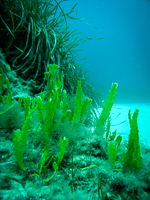ABSTRACT
Two-year monitoring of the invasive marine Chlorophyta Caulerpa taxifolia and Caulerpa racemosa var. cylindracea shows the great influence of substratum on their spatial distribution. The cover of C. taxifolia and C. racemosa was measured in shallow (<8 m) areas indicating that these species are more abundant in rocks with photophilic algae and in the dead matte of the seagrass Posidonia oceanica than in sand or inside the P. oceanica meadow.
A short-term experiment comparing the persistence of C. taxifolia and C. racemosa planted either in a model of dead matte of P. oceanica or in sand shows that the persistence of these species was higher in the dead matte model than in sand. Correlative evidence suggests that C. taxifolia and C. racemosa tolerate near-bottom orbital velocities below 15 cm s−1 and that C. taxifolia cover declines at velocities above that value. These results contribute to understand the process of invasion of these Caulerpa species predicting which substrata would be more susceptible to be invaded and to the adoption of appropriate management strategies.












[…] is very stable since oscillations could affect the data quality. See deployment set ups in Infantes et al. (2011) and Infantes et al. […]